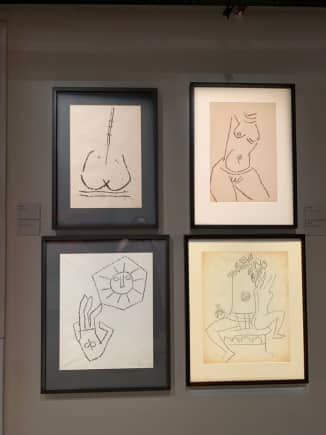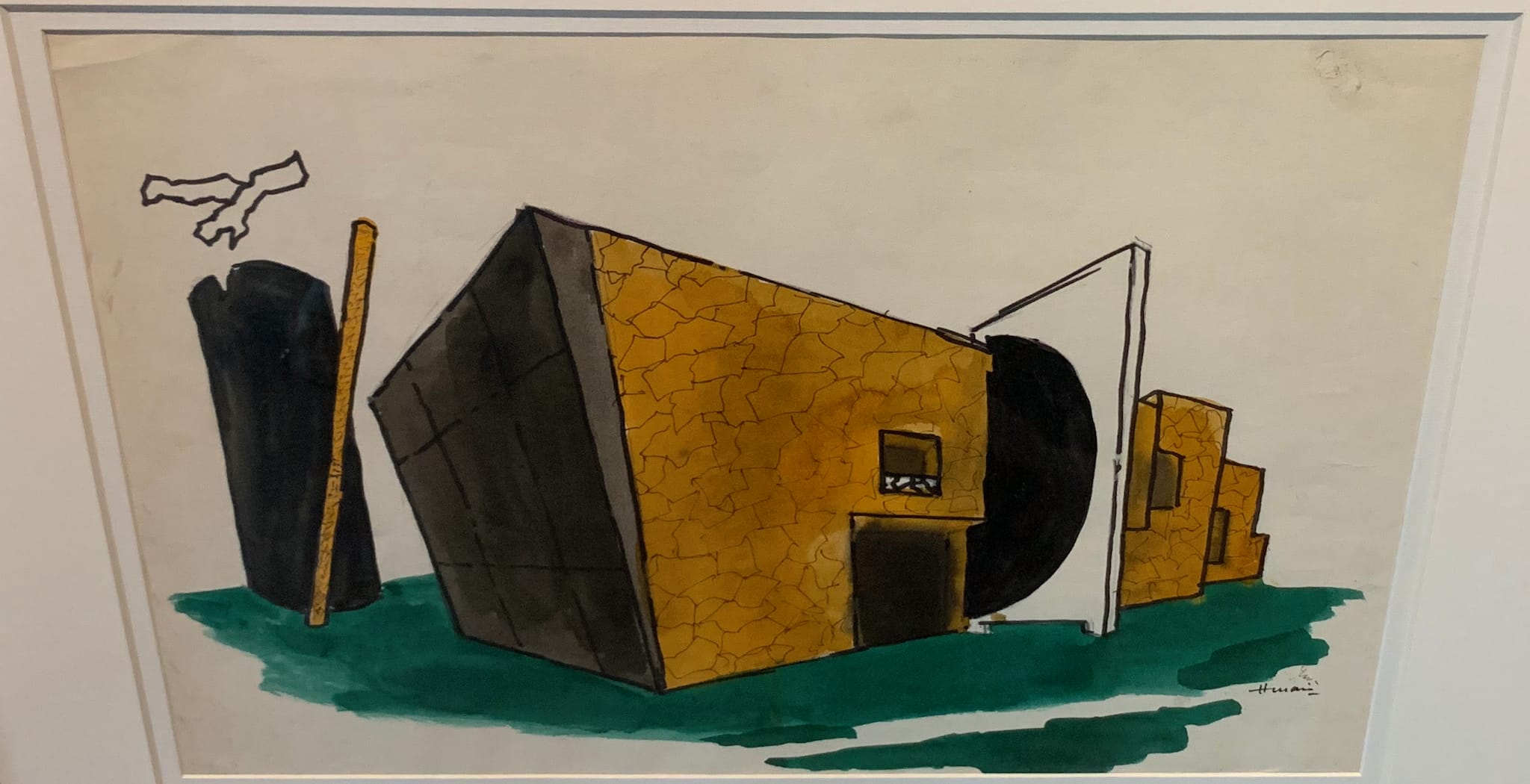



M.F. Husain is easily one of the best-known Indian artists worldwide. And yet, if you were to ask 10 people why M.F. Husain is famous, what kinds of works did he make, you'll probably get six or seven different responses. He was the artist who painted horses, right? Or the one who was inspired by Mother Teresa and Mahatma Gandhi? Or the one who called Madhuri Dixit his muse and cast her in his film 'Gajagamini'? Wasn't he the artist who went everywhere barefoot, even in wintertime in London? A member of the Bombay Progressive Artists group formed in 1947? Someone whose art fetches crores at auctions in India and abroad? Someone who worked with filmmaker Satyajit Ray as well as Tata Group legend Russi Mody? Someone who went into self-exile in Dubai after critics tore into him for painting Indian goddesses in the nude?
The truth is that M.F. Husain had such a long career and was so prolific - and successful - an artist that most exhibitions of his works remind one of the story of the three blind men - you can take in the part that is being shown to you and make of it what you will, but to imagine the whole elephant/oeuvre would require quite the leap.
 Bombay Progressive Artists Group in 1947. (Image via Wikimedia Commons)
Bombay Progressive Artists Group in 1947. (Image via Wikimedia Commons)
Take, for example, the sheer range of things he made. From his movie billboards. To his films (remember 'Gajagamini' starring his muse, Madhuri Dixit?). The wooden toys he designed for the Fantasy Furniture Company after the birth of his first child. Or Amdavad ni Gufa, the underground gallery he worked on with feted architect B.V. Doshi. Or the lines and sketches he drew on restaurant napkins and in people's homes. Or the massive family portraits he made on commission. Or the series he made for national and international exhibitions and biennales. Or the home he "designed" for a friend...
 Kumhar (Toy Series) by MF Husain, at DAG
Kumhar (Toy Series) by MF Husain, at DAG
Think also of the sheer range of materials and sizes he worked with - from scraps of paper (even dinner napkins) to billboards and the massive wall murals at Amdavad ni Gufa in Ahmedabad. Or even the things, traditions and people that inspired him to make art, from Mahatma Gandhi to Satyajit Ray and Mother Teresa to Madhuri Dixit.
To compound the problem of understanding the real M.F. Husain, there's a common tendency to reduce him and his work to a particular style or series - his paintings of horses or Madhuri Dixit or his work with movie billboards, posters, sets. Any such reduction, of course, has the benefit of manageability. But the disadvantage, plainly, is that the viewer goes away without appreciating Husain's genius (one has seen a single large work take up a whole booth at the India Art Fair in recent years) or the sheer breadth of his vision.
 Untitled (Gandhi), at DAG
Untitled (Gandhi), at DAG
A recent exhibition at DAG in Delhi, and an accompanying publication, tries to steer clear of some of these pitfalls, with paintings and works from different series and decades collected in one place (one can only imagine the insurance bill for hosting so many Husain works in one place, and that too a private gallery). Yes, the show has some of the works you would expect: paintings of horses (Husain often drew on things he saw and lived through, like the Muharram processions where the Prophet's horses Duldul would be represented in some way), his family portraits, paintings from his Mother (Teresa) and Mahatma (Gandhi) series and paintings with recurring motifs like umbrellas and old lamps (his grandfather, a tinsmith, would repair them at his shop).
 Untitled (Keehn Family Portrait), at DAG
Untitled (Keehn Family Portrait), at DAG
But there're also others that offer a window into Husain's thinking. A simple line drawing displayed on the lower floor of the gallery reappears as a woman's back - the dimples offering a sensuous suggestion of a lower back.

There are the works he painted for the religions of the world (Theorama) series - including one depicting Sikh Guru Gobind Singh. A letter he handwrote to Madhuri Dixit. Paintings, like Nude on Horse (oil and acrylic on canvas, 19.5 x 14.5 in), where the influence of Gupta period sculpture on his art is evident. A massive (71.2 x 48.0 in) black-and-white oil-on-canvas dedicated to and titled Akira Kurosawa with a quote at its heart: "I have always felt from the first time I met you that you are the kind of man who is like a huge tree. A great tree in the woods in India."
 MF Husain's 'That Obscure Object of Desire (Assam) (Triptych)', painted in the aftermath of the 1983 Nellie Massacre. (photographed at DAG)
MF Husain's 'That Obscure Object of Desire (Assam) (Triptych)', painted in the aftermath of the 1983 Nellie Massacre. (photographed at DAG)
As much as Husain responded to events and ideas around, he also used autobiographical detail - this can be sampled in this show in pieces like Untitled (Autobiography; ink on paper) where he literally writes: A for Abdul (his grandfather)... F for Fida (his father) the timekeeper of Malwa Textile Mill Indore, Z for Zainab the mother of Maqbool...M for Maqbool, H for Husain Horse.
There're also sketches of a home that Husain "designed" for a friend here - it's not a blueprint but it sort of captures a vibe - the colours, components and curvy contours of a space made up of "4 'elements' - A rectangle, one cylinder, one quarter of a circle and an independent pillar leaning at 67.5 degrees / 4 'colours' - Golden yellow of Jaisalmer stone, black granite, white marble and bronze tinted sheets of glass./ The focal point of reference around the whole 'House' is the leaning pillar called 'Kirti Sthumb' with Bronze cladding on which 'Bhagwat Geeta' is inscribed..." (the text, in Husain's cursive hand, goes on).
 House designed by MF Husain (At DAG)
House designed by MF Husain (At DAG)
Through all of these works spanning six decades, letters, sketches, notes scribbled on scraps of paper, multiple series that draw inspiration from so many things in Husain's life and the world around him, one thing remains constant - the visionary artist through whose infinitely creative eyes we see these ideas and images refracted, magnified, explored with a childlike wonder.
 MF Husain's letter to Madhuri Dixit
MF Husain's letter to Madhuri Dixit
Finally, to leave you with one more thing that came up during the earliest guided tours of this exhibition: art historian Gilles Tillotson mentioned how Husain saw his contemporary Rabin Mondal's art. Both had seen their share of hardships (Husain was born in a poor household, his mother died when he still very young, and his father lost his job a little before he was to join the Sir JJ School of Art in Mumbai, to name a few), yet the two artists' expression could not be more different. Story goes that Husain, when he saw Mondal's work, said it was great but filled with so much sadness, Tillotson recounted, adding that Husain's own work had a certain joyfulness. "Perhaps that's why people respond to it even after so many years."
 MF Husain had a lifelong love-affair with cinema. Pictured here, his oil on canvas work titled Akira Kurosawa, photographed at DAG.
MF Husain had a lifelong love-affair with cinema. Pictured here, his oil on canvas work titled Akira Kurosawa, photographed at DAG.
Husain died aged 95 on June 9, 2011, in London. DAG in Delhi has hosted shows of his works earlier, too - including during his lifetime. Like one titled Husain: The Timeless Modernist (same as the current show) with 116 works spanning 60 years in 2004. Twenty years on, the show has something thoughtful about it - as if to point out the impossibility of reducing Husain to set motifs or set ideas. There's his mastery of the craft, of course. But more than that, there is a glimpse into how Husain thought and the worlds that his art opened up to him.
The exhibition, titled Husain: The Timeless Modernist, is on till Saturday (December 14). The accompanying publication, with the same title, is available for purchase at DAG, 22A, Janpath Rd, Windsor Place, New Delhi.
Discover the latest Business News, Sensex, and Nifty updates. Obtain Personal Finance insights, tax queries, and expert opinions on Moneycontrol or download the Moneycontrol App to stay updated!
Find the best of Al News in one place, specially curated for you every weekend.
Stay on top of the latest tech trends and biggest startup news.